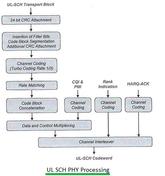SC-FDMA vs. OFDMA: Key Differences Explained
Advertisement
This article compares SC-FDMA and OFDMA modulation techniques, highlighting their differences. We’ll use the example of QPSK data symbols being transmitted, as shown in Figure 1, to illustrate the comparison.
In LTE uplink, a Resource Block (RB) consists of 12 contiguous subcarriers.
For simplicity, Figure 1 only represents 4 subcarriers across two symbols to demonstrate the differences between the two techniques.
 SC-FDMA vs OFDMA
SC-FDMA vs OFDMA
Let’s summarize the key differences between SC-FDMA and OFDMA based on Figure 1:
- Parallel vs. Serial Transmission: OFDMA transmits 4 QPSK symbols in parallel, with one data symbol per subcarrier. SC-FDMA, on the other hand, transmits QPSK symbols serially but at 4 times the rate compared to OFDMA. Consequently, a QPSK symbol in SC-FDMA occupies a much wider bandwidth, approximately M x 15kHz, where M is the number of subcarriers.
- Multi-Carrier vs. Single-Carrier: OFDMA is a multi-carrier system where each subcarrier carries one data symbol. SC-FDMA is a single-carrier system where each QPSK symbol is carried by a single subcarrier with a much wider bandwidth.
- Symbol Length and Sub-Symbols: Although the symbol length remains the same (approximately 66.7µS) in both OFDMA and SC-FDMA, an SC-FDMA symbol contains multiple sub-symbols, representing QPSK data symbols.
- PAPR (Peak-to-Average Power Ratio): The parallel transmission of multiple data symbols in OFDMA leads to a higher PAPR. In SC-FDMA, the PAPR is the same as that of the original QPSK data symbols because M QPSK data symbols are transmitted serially at M times the rate compared to OFDMA.
 difference between SC-FDMA and OFDMA
difference between SC-FDMA and OFDMA
Figure 2 illustrates the block diagrams of SC-FDMA and OFDMA systems. The figure highlights the modules unique to SC-FDMA and those common to both systems. As mentioned, the DFT before the IFFT in OFDMA and the IDFT after the DFT in the SC-FDMA system differentiate the two.
Advertisement
 RF
RF



